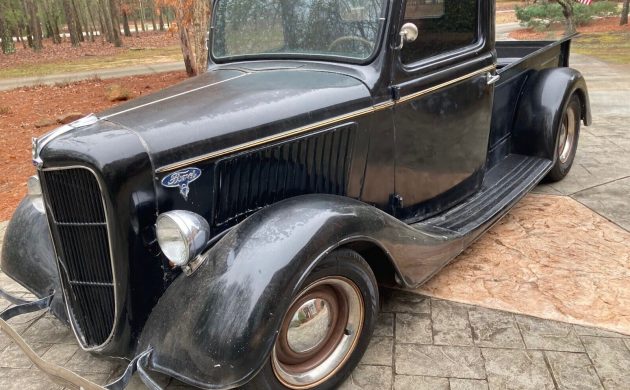
In the yin and yang of the automotive world, the salad days of old car restoration of the sixties through the eighties were met with an equal and opposing force in the form of hot rodding. Thousands of old cars were chopped, channeled, and otherwise converted to their owner’s dream machine or a pile of junk out back when abilities didn’t match those dreams. Many of those hot rods are still lurking in barns and garages waiting to be rediscovered and refreshed. A good example would be this 1936 Ford pickup for sale on eBay in Oxford, Georgia. While this truck’s body managed to escape the torch except for the firewall, the rest is pure vintage home-built hot rod. With a starting bid of $20,000, is this a truck you could freshen up and enjoy, or would the craftsperson in you rather strip it down to the frame and use it as a base for your masterpiece?
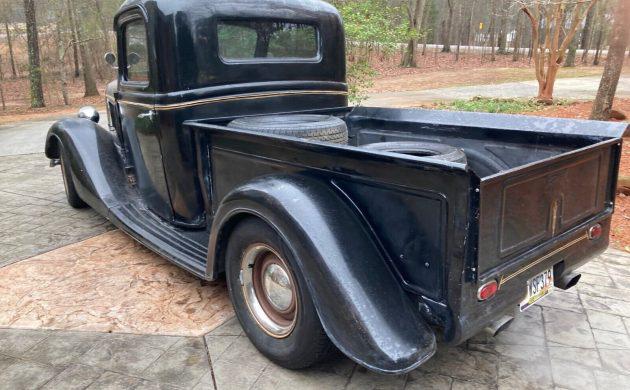
The truck you see here is typical of hot rods of that era. Every hot rod show had an absolute plethora of cars that contained a Mustang II front suspension, a Vega steering box, a Chevy small block V-8 (usually a 327 with Corvette valve covers), a Powerglide, or maybe a Turbo 350, a Ford 9″ rear end, and a set of VDO gauges. Extra points went to cars and trucks with a Jaguar rear end, air conditioning, or a big block engine. Whether the parts were new or fresh from the junkyard depended on the depth of the builder’s pockets, and most paint jobs were easy to spray lacquer. It was a good time to be into hot rods, and a creative builder could turn out a nice, drivable car for peanuts compared to the magazine cars that drove the trends ever forward.

The truck you see here is a tastefully put-together 1936 Ford pickup in basic black with a proper rake to its stance. According to the seller, it is powered by a 327 cubic inch small block Chevrolet engine backed with a Turbo 350 automatic transmission. The front suspension has been changed from the original solid front axle to an independent setup. While the type is not specified, it is likely a Mustang II setup. It also has a power rack and pinion steering and a tilt steering wheel to make driving it less of a workout. On the front are disc brakes with drums helping to slow forward progress. The dash is set up with VDO gauges in place of the original Ford units.
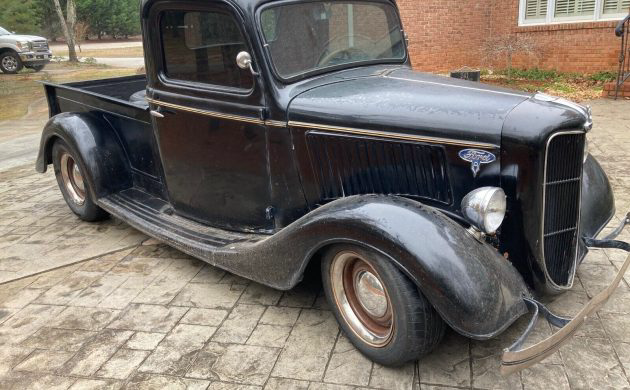
Outside, we see a truck that would have probably benefitted from some detailing before the pictures were taken. There is definitely wear and tear on the vehicle, but it would be nice to see the extent to which the clear coat has deteriorated. The front bumper looks to be identical to the ones found on 1935 or 1936 Ford passenger cars. There is no back bumper, only a piece of sheet metal holding the taillights. The dual exhaust looks good under the stock-appearing tailgate.
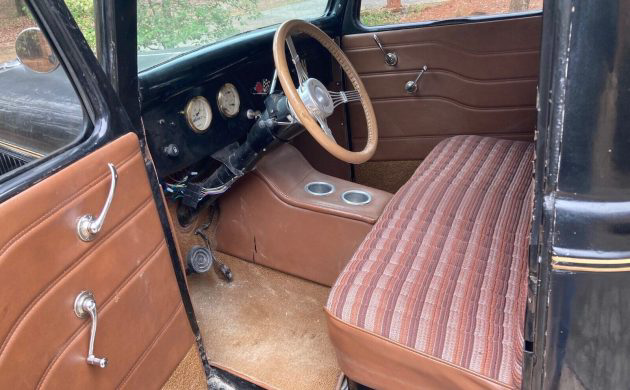
Inside, we see a large center console covered in vinyl that has cracked or ripped. This center console does house two drink holders but takes up a lot of real estate in an already cramped cab. The previously mentioned gauges and tilt wheel are there to see along with a set of rather tasteful door panels. The cloth insert in the seat could only be described as an acquired taste. Looking at the damaged finish in the door jamb makes one question the location and effectiveness of the weatherstripping.
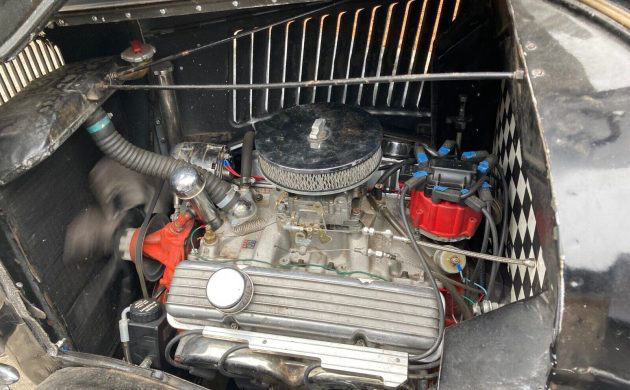
As you can see from the moving fan in the picture, the truck’s 327 engine does run. We are also told that it is capable of driving around as well, but that it needs work. The exact work that is required is left out of the description. Under the hood, we see an interesting mix of old and new. The radiator seems to be the stock piece that this truck left the Ford factory with. The manifold, carburetor, distributor cap, spark plug wires, and the billet spark plug wire holder all appear new. The spacer for the fan, the alternator, and the air cleaner look like they have some age to them. Also standing out is the power steering pump. It looks to be a nineties piece, but we are open to anyone leaving in the comments their estimate of when it was produced. Sadly, the cowl was not only cut up, but the metal insert has to suffer the indignity of a checkered flag-type decal.
With some work to update this truck, it would likely be a reliable driver for someone who just wants to enjoy going to local meets and shows. If you were looking for something that could win trophies at those shows, then a re-do would be necessary. You could likely keep the drivetrain, paint the body, get rid of the period mismatched engine components, freshen the interior, and have a pretty awesome truck. Replacing the radiator with a modern aluminum one and getting rid of that godawful checkered flag cowl decal would make it perfect. Hopefully, it will find a good home soon.
What would you do with this truck if you made the winning bid? Please share your thoughts in the comments.





Good write up, Jeff. This looks like every hot rod project in every rodders garage of those times.
This one could benefit from some period improvements as you pointed out but change it as minimally as possible just to keep that flavor. Clean up the paint, clean up the mechanicals put some new rubber on it and smile on down the road.
What he said. Love it just like it is. It was a good build to start with. No sense in modifying anything. It’s already a “masterpiece”.
The only indignity on this old Ford truck is the drive train.
I agree a nice old Ford like others has a Chevy engine in it. Same old thing chevys are plentiful so that’s what people put in. I’m a pro ford so it should have a 302, or 289 ect ect. I’ve turned many sales away because of a chevy engine in a Ford. Just my 2 cents
Seriously, someone please explain why hotrodders, notorious for scorning authenticity, suddenly defend “correctness” when an engine of, say, a Ford is seen in, say, a Chevrolet that’s already been mongrelized beyond any chance of restoration.
Absolutely totally agree. But I get it, a mate of mine, builds 33’s for a living, and always uses GM donks. Because for half the price of a Ford donk, you get more HP.
Ford in Ford, GM in GM, with the only exception MAYBE a hemi.
Early rods, if not sporting a hopped flathead, might have had an Olds, Caddy, or early Hemi among a variety of choices. And you’d have actually had to shift gears but that was part of the driving experience. Imagine putting in a Chevy power plant just to rile the haters. And the period imperfect console where functional gear stick should be.
I agree, I grew up in an Oldsmobile family so a 371 w/J2 and 3 speed would be my first choice….but a Nailhead would be fine too. No matter what motor, none of my friends would have wanted and automatic, that was for mom’s car.
Jump in, drive and enjoy!
Nice set up love the 327 and look no bloody headers nice . The fan got to go electric fan in place .
Yes there were (and still are), plenty of Rods with Vega steering boxes, none of them were attached to a Mustang II front suspension,. The MII came with rack and pinion. The Vega box was used with solid axles on Model As, ’32s, etc.
Chopped and channeled sounds cool as it rolls of the tongue, but many were chopped, few were channeled. At least in my observations.
I see absolutely nothing wrong with that checkerboard. It’s an old school thing. And it’s a old hotrod. I would just drive it the way it is. If you want a trailer queen you can have one.
I would put a set of 35 / 16″ wires & W/W tires on it , detail it and drive the heck out of it , wish I could afford it .
Looks like it not going to sell. To much cash.. still a nice survivor. I would drive it as is. 8500 sounds good to me..
This is just beautifull and I am building one. I love this truck , but there are too many things that I would do different . So I will keep on building and have more money in my version, I wish I had seen this beore I started
I’m a fan of vintage Ford pickups, especially those from the 30s. I am definitely NOT a fan of dropping a Chevy engine into a Ford but I will say this: the SBC is about as adaptable as an engine can get. Drop in a Small Ford newer than a Y-Block and you have to deal with a front sump and start looking for a Bronco/small 4×4 oil pan. The Ford engine is also longer, necessitating modification to the firewall. Nonetheless, my hat is off to someone keeping the engine in the family.
I’ve got a ’35 that I hope to get further along this year. Mine was a farm truck, right down to the grain door in the tailgate. Its frame was broken and poorly welded at least three times. It’s sprung as well. Although I’m a purist restorer I’m seriously considering ordering a custom rolling chassis. All stock body mounts. It’s got IFS in front and 4-Link in the rear. Dual Braking system and a Ford 9-inch rear. You can order it to fit any kind of engine you want so I would order mounts for a Flathead V8. I might even be tempted to adapt a C-4 automatic. With a set of Vintiques wire wheels with Ford hubcaps, from a distance, it would look like any other ’35 pickup but the details would be subtle; no one would really know. The cost and hassle of restoring the stock chassis versus installing a rolling chassis seems like a no-brainer. I guess we’ll see…
To start, clean it up and get it running properly to enjoy. The upgrades would start with throwing the console in the fire pit, and sourcing some “Corvette” valve covers. Down the road- fix the indignity, and drop a mildly beefy 351W in place of the 327.
Oh, I forgot to say I am putting a 292 Y block into my 39 Ford truck However If I found one with that motor in it well I would be very interested
The corvette covers would be a bad choice it’s not a corvette.